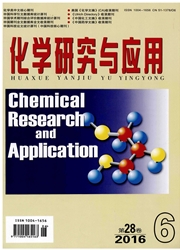

 中文摘要:
中文摘要:
采用密度泛函B3LYP/6-311G方法,对3-卤(-F、-Cl、-Br)代吡唑几何构型进行了全自由度优化,获得了它们的几何结构和电子结构。计算结果显示,Nl-H型的稳定性大于N2-H型。计算并考察了3-卤代吡唑进行结构互变的质子转移过程的四种可能途径:(a)分子内质子转移;(b)水助质子转移;(c)同种二聚体双质子转移;(d)异种二聚体双质子转移。计算结果表明(以3-氟代吡唑为例),途径d所需要的活化能最小(54.89kJ/mol),而途径8所需要的活化能最大(198.83kJ/m01),途径b和c的活化能居中间分别为(104.05kJ/mol和69.05kJ/m01)。研究还表明氢键在降低活化能方面起着重要的作用,卤素(-F、-Cl、-Br)对活化能的影响不大。
 英文摘要:
英文摘要:
Molecular structures of 3-halogeno pyrazole were investigated at the B3LYP/6-311G level in the gaseous phases with full geometry optimization. The geometrical and electronic structure of tautomers of 3-halogeno pyrazole and their transition states were obtained. The results of the calculation indicated that N1-H tautomers form is more stable than N2-H form. The four possible reaction pathways: (a) intramolecular proton transfer; (b) water- assisted intermolecular transfer; (c) isomerization by double- proton transfer in the dimer and (d) intermolecular proton transfer via the complex formed by 1 and 2 were investigated in the present paper. The calculated results showed that the processes in (b), (c) and (d) has lower activation energies than that of the intramolecular tautomeric reaction (a) because of the formation of hydrogen-bonded complexes in (b), (c) and (d). The activation energies for the four reaction processes are 198.83, 104. 05,69. 05 and 54. 89 kJ/mol respectively. It is likely that the hydrogen bonds formed in the complexes play an important role in proton transfer processes in the later three reaction pathways.
 同期刊论文项目
同期刊论文项目
 同项目期刊论文
同项目期刊论文
 The synthesis, light-harvesting, and photocatalysis of naphthylporphyrin-functionalized platinum nan
The synthesis, light-harvesting, and photocatalysis of naphthylporphyrin-functionalized platinum nan Gold/platinum bimetallic core/shell nanoparticles stabilized by a fréchet-type dendrimer: Preparatio
Gold/platinum bimetallic core/shell nanoparticles stabilized by a fréchet-type dendrimer: Preparatio 期刊信息
期刊信息
